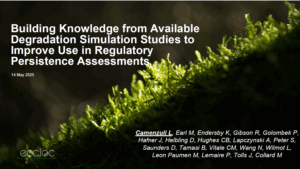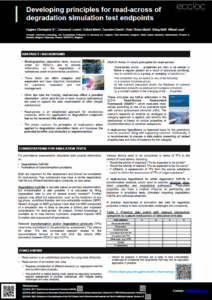Building knowledge from available degradation simulation studies: analysis of the most influential factors & development of a grouping approach
Background
Degradation simulation studies are complex and technically challenging. Additionally, they are used to evaluate a broad range of industrial chemicals, with increasing data/testing requirements e.g. NER, testing temperature. Over the last few years, there has been an increase in requests from ECHA to generate degradation simulation studies in the scope of Dossier Evaluation. Furthermore, the inclusion of the new PMT/vPvM hazard classes within CLP in 2023 (and the guidance revision 2023-2024) and possibly as SVHCs in the REACH revision (2024), will lead to more substances requiring a P assessment.
Objectives
- Collect and curate the information available from degradation simulation studies
- Identify the most influential factors driving results in simulation studies, and potential limitations in current test set-up and data interpretation
- Compare screening study mineralization rates with half-lives in OECD 309 studies
- Build read-across / grouping strategy for persistence assessment & develop guidance, in particular for UVCBs
The concepts in the ECHA read-across assessment framework (RAAF), published in 2017, will be considered in terms of the read-across/grouping.
Timeline
It is foreseen that the Task Force will complete its work in 21 - 24 months, starting October 2023.
Deliverables
- Curated database of simulation studies
- Manuscript describing any correlations using available simulation studies and potential recommendations.
- Manuscript on regulatory relevant grouping strategy for persistence assessment.
Recent updates and publications
'Building Knowledge from Available Degradation Simulation Studies to Improve Use in Regulatory Persistence Assessments' - Platform presentation at 2025 SETAC Europe Annual meeting in Vienna
'Developing principles for read-across of degradation simulation test endpoints' - Poster presented at 2025 SETAC Europe Annual meeting in Vienna
'Building knowledge from available degradation simulation studies' - Poster presented at 2024 SETAC Europe Annual meeting in Seville



